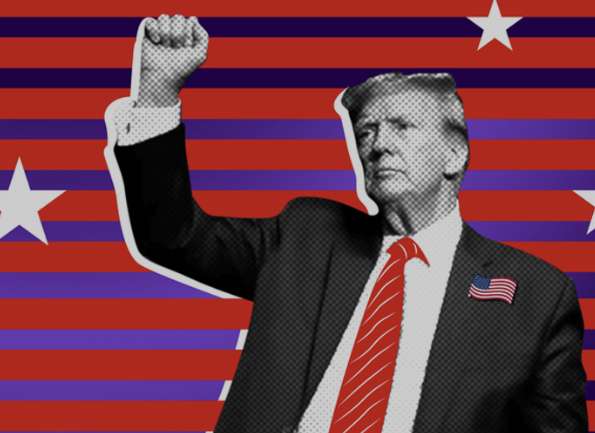The Real 'Trump Trade': A Great American Sell-Off
Donald Trump has only been back in the White House for two months, yet the pillars of America's financial hegemony, built over nearly a century, have never seemed so shaky.Trump once again explicitly

Donald Trump has only been back in the White House for two months, yet the pillars of America's financial hegemony, built over nearly a century, have never seemed so shaky.
Trump once again explicitly threatened to fire Chair Jerome Powell- a move that only intensified the full-scale trade shock he has unleashed. Investors are now forced to reassess the assets underpinning America's economic dominance. The U.S. dollar and Treasury bonds, traditionally safe havens in times of turmoil, suddenly appear far less appealing. Not long ago, traders were anticipating the so-called "Trump trade," betting on a resurgence of American exceptionalism. Now, it looks more like a sell-off of U.S. assets.
This shift is even broader and could bring more pain. The role of American households as the ultimate buyers of global goods, as well as the centrality of the U.S. military in security and political alliances, is also being called into question.
Governments and fund managers worldwide now find themselves in the same boat, scrambling to adjust course. Against this backdrop of global turbulence, the International Monetary Fund (IMF) is convening its spring meetings. This week, economic leaders will gather in Washington- long the heart of the world order but now a hotbed of upheaval.
Adding to the unease, Trump has ramped up his rhetoric against the Fed, demanding immediate rate cuts. While legal experts question whether he even has the authority to fire Powell, investor confidence in the Fed's independence- and the rule of law itself- may already be eroding. These were once key attractions of U.S. markets.
In a Monday report downgrading their dollar forecast, barclays strategists wrote, that while they still view the removal of the Fed chair as a low-probability event, the potential reality of diminished Fed independence poses too great a dollar risk to ignore.
Of course, the sheer size of the U.S. economy means its decline won't happen overnight. But the recent turmoil can't simply be dismissed as an unintended side effect. Amid market chaos, Trump did roll back some tariffs, but his administration has made it clear it seeks fundamental changes on all fronts, arguing that other nations have long free-ridden on the dollar, American consumers, and U.S. military might.
"Loss of Confidence"
The U.S. has long relied on its consumption-driven economy and the dollar's role as the foundation of global finance and trade, widely seen as a source of advantage. Trump and his team, however, focus on the perceived costs- including job and manufacturing losses, as well as massive debt to the rest of the world.
The U.S. finances its fiscal and trade deficits through capital inflows. But after April 2, money didn't flow into America- it fled. That was the day Trump stood in the White House Rose Garden, waving a chart as he announced plans to hike tariffs.
According to Torsten Slok of apollo management, foreign investors hold $19 trillion in U.S. stocks, $7 trillion in Treasury bonds, and $5 trillion in corporate debt, accounting for roughly 20% to 30% of the market. Unwinding these positions would be excruciating.
"Consider the damage to America's reputation by this sudden pivot to highly protectionist policies," says David Kelly, chief global strategist at jpmorgan Asset Management in New York. The resulting loss of confidence in American policy "reduces the price people are willing to pay for US assets."
Domestically, Trump's tariffs have thrown consumers and businesses into disarray. Companies facing weak demand, rising input costs, and foreign retaliation have seen their stocks plummet. The S&P 500 has fallen nearly 10% since April 2, wiping out about $4.8 trillion in market value.
The Bloomberg Dollar Index has dropped more than 7% this year, its worst annual start since its launch in 2005. However, the most striking move has been in treasuries, which typically rally during market turmoil- as they did after 9/11 and during the financial crisis.
This month, however, the 10-year Treasury yield posted its biggest weekly surge in over two decades. Reports that Trump scaled back some tariff plans due to bond-market turmoil briefly pulled yields back from a high near 4.6%. But they climbed again after his latest Fed broadside.
The dollar's decline alongside rising Treasury yields has surprised some investors, as the two usually move in tandem. Now, their correlation is at its weakest in three years- a sign of broad aversion to U.S. assets and skepticism toward traditional hedges.
"The thing that's been the most surprising has been that Treasuries and the dollar are not behaving in the safe haven role that we've seen before," said Tracey Manzi, senior investment strategist at Raymond James & Associates.
Disclaimer: The views in this article are from the original Creator and do not represent the views or position of Hawk Insight. The content of the article is for reference, communication and learning only, and does not constitute investment advice. If it involves copyright issues, please contact us for deletion.